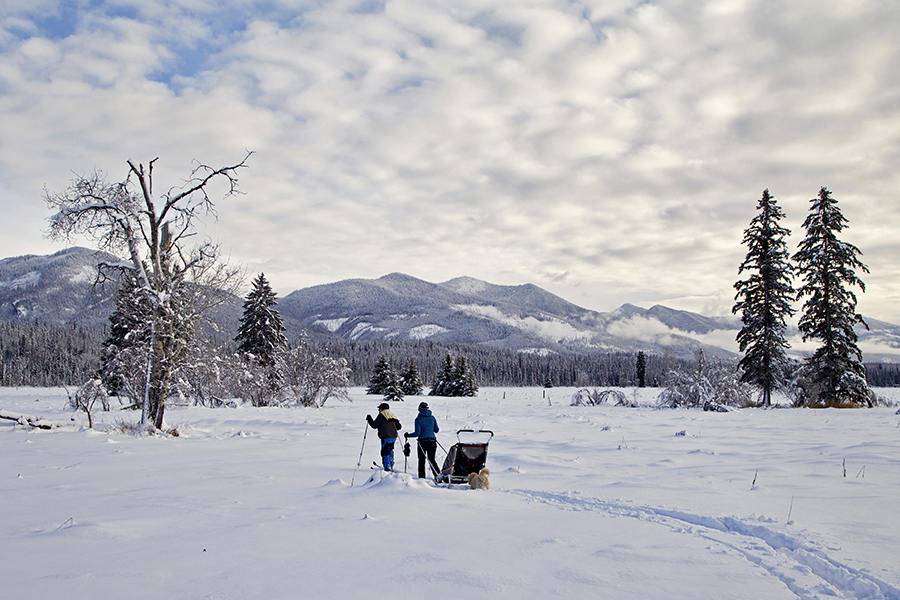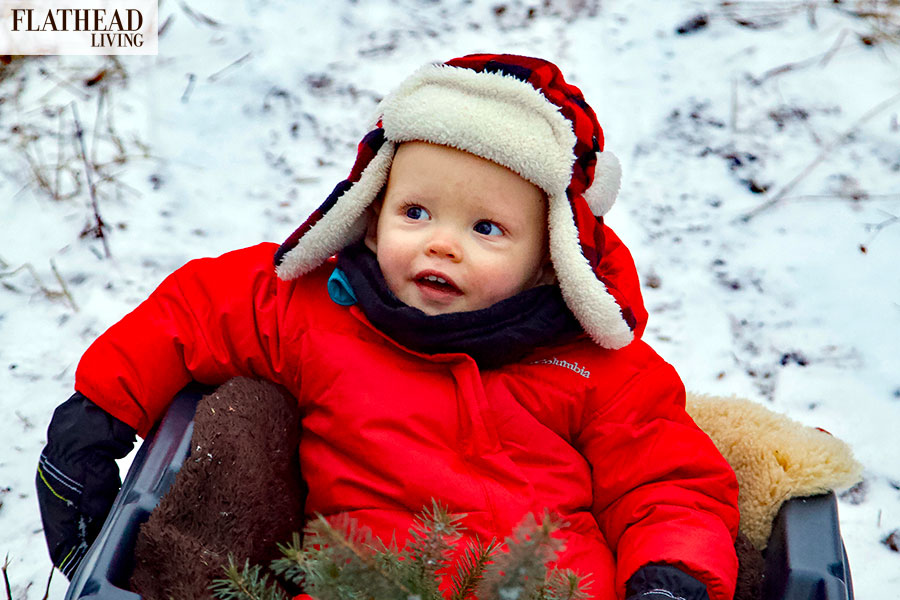The first snow came early this year, still September and barely fall. At the sight of the twirling snowflakes, my 3-year-old grandson Wyatt threw up his arms and declared emphatically, “I love winter!”
I chuckled as I flashed back to his first winter outing. Risa’s first baby and our first grandbaby, Wyatt was just six weeks old when he came to Swan Lake from San Francisco for an early start to Christmas. I could say having a baby seems like a long time ago and like yesterday in the same breath. Now I am enjoying round two with two grandchildren and relishing a rerun of these precious memories, while also clearly remembering that playing outside in the winter with babies and kids can be tricky.
Coming from a California climate, Risa was excited to get back to a Montana winter, so she bundled Wyatt in a down bunting and a baby-front carrier for a short outing on a snowy road. His body stiffened, his eyes pinched tight and his mouth opened to release a wail that pierced the snow-muffled silence of the quiet winter day. As far as he was concerned, the soft bunting was a straight jacket, inhibiting his already limited range of movement. Now what? We were all a little anxious but turned to the old family standby: when in doubt, get moving. Shortly afterward, the crying stopped. Minutes later, he was asleep, and we were walking through trees draped in fresh snow under a canopy of melting gray skies.
We raised Risa and her sister Kelsey on Swan Lake, and as fall babies, they were introduced to snow at just a couple of months old. They learned to ski and skate before they were 3, and during short winter days, they often skated in the dark before the school bus arrived, skied and sledded in nearby woods after school and built forts from sheets of lake ice pushed onto the shore.
The nature of nature hasn’t changed a lot since then, but the gear and my perspective have. We felt cutting-edge with our outdoor baby gear, including a soft-front pack and basic metal-frame backpack, but equipment has come a long way — to fancy chariots on skis, high-tech clothing and a myriad of easy snacks that come in handy little packages that remind me of astronaut food.
Despite an abundance of hours and adventures spent in winter, it’s not easy to package up our experiences to offer a list or prescription for playing outdoors in the winter with babies and kids. Every kid, every parent and every family are unique, which requires learning and determining what works best for them.
It might appear to others that we pushed the envelope with some of our outings, but for us, they felt right. We were just blending our kids into our life, doing what we always have with adaptations and modifications to make the experiences fun and safe for little ones. I think our family history — which includes genetics, lifestyle, geography and experiences — also gives us an intuition for what will work and what won’t.
For us, it was fine to bundle up the kids and take them out on a frozen Swan Lake. It was our front yard, and we did a continuous survey of the ever-changing winter landscape. And it was normal for me to strap baby Risa snug against my chest in a front pack and tag along with Dewey as he trudged through newly falling snow in hunt of a deer, because it was in a familiar forest that felt like our extended neighborhood. And it was perfectly comfortable to load them up in a sled to search for a Christmas tree with a headlamp under the moonlight. But I know that isn’t for everyone. The last thing you want to do with babies or children is overextend yourselves or get in over your head.

But what I can tell you is:
Begin slowly
Start with shorter outings until baby and kids are acclimated and have adjusted to winter conditions. Go with another more experienced family if you are still learning about kids in the outdoors.
Have a plan
Plan an outing around nap and mealtime to increase the chances for a successful outing. Bring snacks, water, extra clothes and the diaper bag.
Be flexible
Don’t get fixated on preset goals for a specific destination or length of time. There is a fine line between encouraging and torturing your kids. Be willing to turn back. At the same time, don’t let a few discouraging words make you give up. Sometimes you can push through a rough spot to get to a happy place and make a great memory. And it truly can build character.
Go carefully
This is especially important for new parents and especially for new parents who are also new to winter. Cold weather is unforgiving and can become critical with risks of frostbite and hypothermia if you are unprepared or not dressed properly for the conditions. Invest in good waterproof and water-repellant winter gear. A punch list could include: snowsuit, long underwear, sweater, neck warmer, warm socks, mittens, hat and warm boots. Buntings with hoods and built-in mittens and stroller sleeping bags offer a one-piece option to keep baby tucked in. Keep them as dry as possible by brushing off snow before it melts from their body heat.
Make it fun
Choose activities that are fun for everyone. If you haul your kids in a pack, sled or chariot while attaining your own personal exercise goals, make sure you reward them with a fun snow activity afterward. Sing songs, tell stories and talk about your surroundings as you trek through the snow. Then make a snowman or just let them play and run in the snow before you load them up for the return home.
What the doctor says:
Kalispell pediatrician Dr. Mike Schwaller has plenty of winter experience. He was raised in Montana, completed his residency in Wisconsin, practiced in Anchorage, Alaska for 10 years, and returned to Montana in 2008 to join Sunny View Pediatrics in Kalispell. Offering both professional and personal expertise as a pediatrician and father of three, his first piece of advice is: “Just get outside! Parents need to spend time outside in the winter for their mental and physical health. A healthy parent creates a healthy kid.”
Dr. Schwaller is quick to note that when the outside temperature drops below freezing, you have to be particularly careful with newborns and infants because of their increased skin surface to weight ratio. Newborns also may not have enough body fat. When babies are carried against your body in a baby pack, they benefit from your body heat but still require diligent surveillance to make sure they are warm enough. By the time they are 6 months old, increased body fat and more neck control better equip them for winter outings. On the flip side, you want to make sure they don’t get too hot and sweaty, which will end up making them colder.
Dr. Schwaller says checking your child’s hands and feet for warmth is helpful. He would not rely solely on skin color since skin can be red or white with a cold injury. He notes, “Once you get to know your baby, you will know better… If they are cold, they might show it by getting cranky.” Regardless, you should still monitor them frequently.
As they get a little older, Dr. Schwaller says a rule of thumb is to dress small children as you dress and then add a layer. Older kids can dress as you would. He said you could actually take their body temperature to see if they are warm enough, but that might be a little extreme. “The Alaska natives would laugh at this conversation. For generations, they have known how to keep warm. In my 10 years there, I never saw a case of frostbite.”

More tips from Dr. Schwaller:
Strategize to help make an outing go smoothly.
Use common sense.
Use ice-traction devices on your boots when carrying a baby or child on ice and snow.
Make sure babies have a dry diaper and kids have used the toilet before getting dressed.
Feed them before you go and bring along easy snacks.
Play games such as finding things or hide and seek to keep them engaged.
Layering is important so you can add or subtract clothing as needed. Keep skin covered, but make sure the baby’s mouth is not covered.
When bundling a baby in a sled or chariot, use only as directed by the manufacturer.
As a general rule, consider limiting outings for newborns to simple transport to and from the car when below freezing and, for older infants, when less than 20 degrees. Since a windy, cloudy day poses more risk than a windless, sunny day, these guidelines are not set in stone.
From a safety standpoint, kids should not wear bulky coats while in their car seat because in the event of an accident they are more likely to be thrown out of their car seat. Cover them instead them with a blanket or coat.
Use hand warmers as directed. Never apply directly to skin because they can cause serious burns on infants (or kids who ignore discomfort caused by them).
Healthychildren.org is a website created and managed by pediatricians with an expansive range of articles regarding kids’ health.
Read more of our best long-form journalism in Flathead Living. Pick up the winter edition for free on newsstands across the valley, or check it out online at flatheadliving.com.
